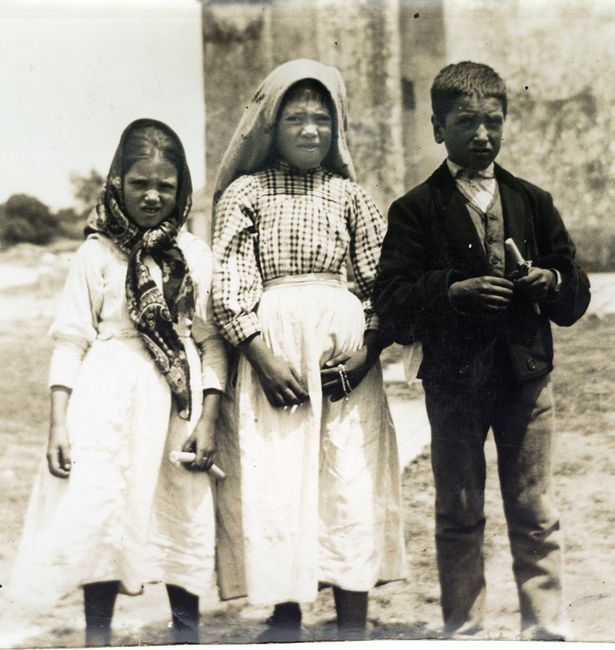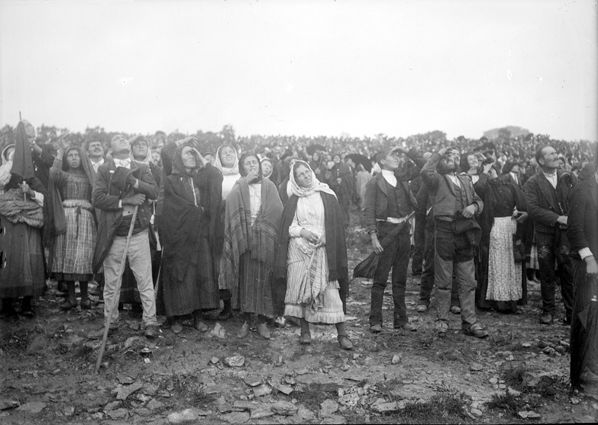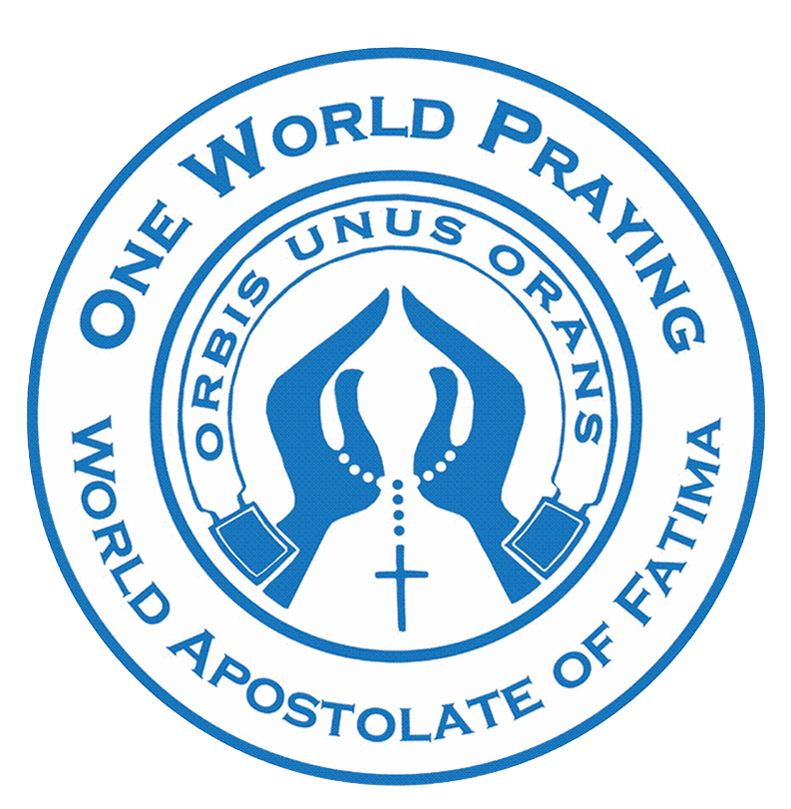The Message of Fatima
Between May 13 and October 13, 1917, the Virgin Mary (Our Lady) made appearances to three shepherd children in Fatima, Portugal.
The quaint village of Fatima, Portugal, served as the backdrop for a remarkable series of divine encounters gifted to humanity by God, which have been recognised and validated as authentic by the Catholic Church.
Three young shepherd children—Francisco, Jacinta, and Lucia, aged 10, 9, and 7 at the time—were selected by Our Lady to act as messengers during this pivotal moment in history, where they would experience apparitions of the Angel of Peace (or Angel of Portugal) in 1916 followed by Our Lady herself later in 1917.
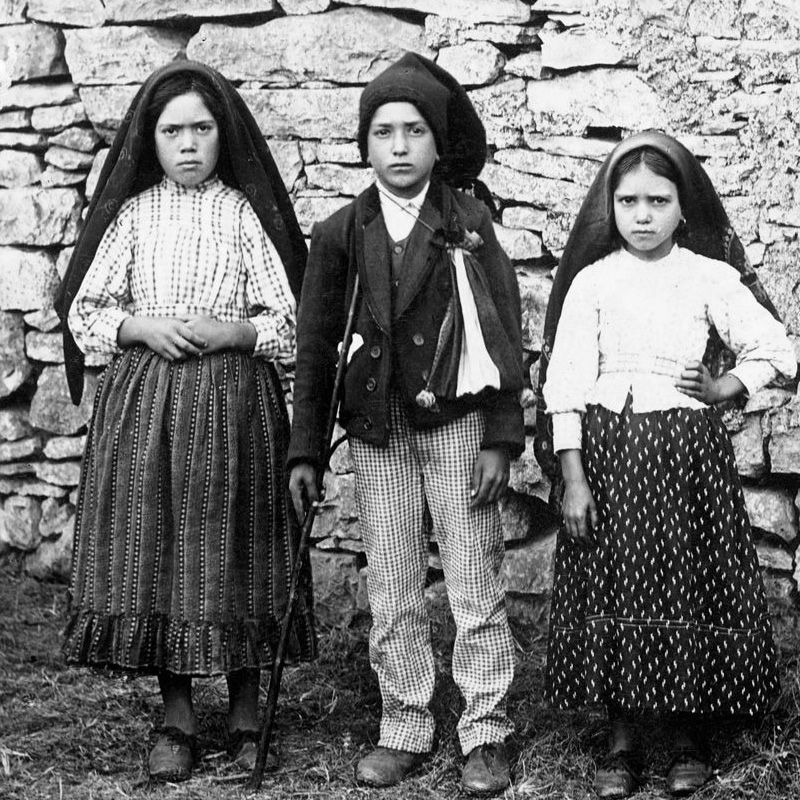
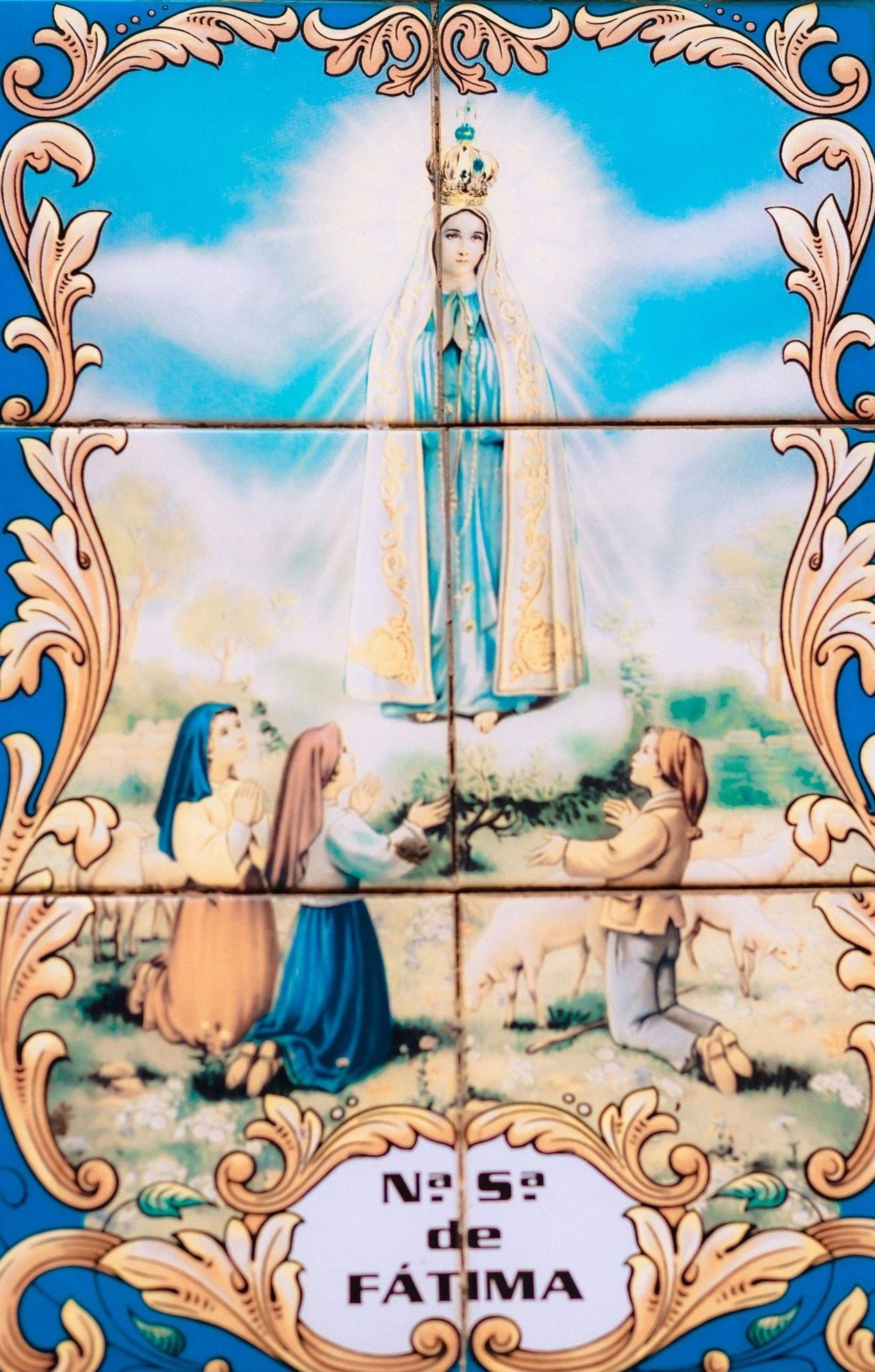
Listen to Our Lady of Fatima's Hymn
The three children, Lucia dos Santos, Francisco Marto, and Jacinta Marto, hailed from the small hamlet of Aljustrel, a quaint and picturesque village nestled just about 2 kilometres from the renowned Cova da Iria, the sacred site where the miraculous apparitions of Our Lady occurred.
On that fateful day of May 13, 1917, the Blessed Virgin Mary made her momentous first appearance to the children, captivating their hearts and igniting a profound spiritual journey.
Over the following months, Our Lady graced the children with her presence six times in total, between May and October of that same year, each visit leaving an indelible mark on their souls and drawing them ever closer to the divine.
She gave them a Message which involved prayer, reparation and sacrifice. She also encouraged them to pray the Rosary every day for peace.
In June 1917, she told them God wanted to establish the devotion to her Immaculate Heart throughout the world, with a promise of salvation for those who embraced it.
Finally, on October 13th, 1917, Our Lady identified herself as the Lady of the Rosary, imbuing the occasion with significant spiritual depth and power.
For those who hold the Rosary dear, this message from Fatima serves as a vital source of inspiration and a profound means to enhance one's spiritual growth and connection to God.
The Angelic Apparitions of 1916
At the time of he first Angelic apparition Lucia was helping to look after her family’s flock of sheep and goats, an activity she would often undertake from an early age. It was probably in the summer of 1915, while she was out with some other little girls, that she had her first overt encounter with the supernatural.
As they were saying their rosary they saw a cloud whiter than snow moving through the air, but transparent and in human form; this was repeated on two subsequent occasions, and these events naturally caused much puzzlement in the community when related by one of the girls.
Lucia was questioned by her mother but could only tell her that she had seen what looked like somebody wrapped in a sheet.

1st Apparition of the Angel, Spring 1916
In the spring of 1916, Francisco and Jacinta were allowed to go out with their cousin Lucia as she looked after the sheep. They were in an area known as the Loca do Cabeço one morning when they were surprised by a strong wind shaking the trees. Then they saw “a light whiter than snow, in the form of a young man, transparent, and brighter than crystal pierced by the rays of the sun,” coming nearer, until they could see his features and he spoke to them:
“Do not be afraid, I am the Angel of Peace. Pray with me.”
He then knelt and touched the ground with his forehead, the children following his example, before continuing:
“My God, I believe, I adore, I hope and I love You! I ask pardon of You for those who do not believe, do not adore, do not hope and do not love You!”
He repeated this prayer three times before rising and saying: “Pray thus. The Hearts of Jesus and Mary are attentive to your supplications.” Then he gradually faded away in the sunlight, to leave the children repeating the prayer for hours, until towards evening they returned home, keeping silent about this encounter.
2nd Apparition of the Angel, Summer 1916
Some time during the summer the children were by the well in Lucia’s garden one afternoon, when the Angel suddenly appeared before them again: he gently admonished them saying: “What are you doing? Pray! Pray very much! The Hearts of Jesus and Mary have designs of mercy on you. Offer prayers and sacrifices constantly to the Most High.”
Lucia asked how they could do this and he replied:
“Make of everything you can a sacrifice, and offer it to God as an act of reparation for the sins by which He is offended, and in supplication for the conversion of sinners. You will thus draw down peace upon your country. I am its Angel Guardian, the Angel of Portugal. Above all, accept and bear with submission, the suffering which the Lord will send you.”
Lucia later wrote about the effect of this apparition:
“These words were indelibly impressed upon our minds. They were like a light which made us understand who God is, how He loves us and desires to be loved, the value of sacrifice, how pleasing it is to Him and how, on account of it, He grants the grace of conversion to sinners. It was for this reason that we began, from then on, to offer to the Lord all that mortified us, without, however, seeking out other forms of mortification and penance, except that we remained for hours on end with our foreheads touching the ground, repeating the prayer the Angel had taught us.”
3rd Apparition of the Angel, Autumn 1916
In the autumn the children again saw the Angel as they were out looking after the sheep. They had said the rosary and the prayer they had been taught, when he appeared before them, holding a chalice in his hands. Above it was suspended a host from which drops of blood were falling into the chalice. The Angel left the chalice suspended in the air and prostrated himself before it, repeating the following prayer three times:
“Most Holy Trinity, Father, Son and Holy Spirit, I adore You profoundly, and I offer You the most precious Body, Blood, Soul and Divinity of Jesus Christ, present in all the tabernacles of the world, in reparation for the outrages, sacrileges and indifference with which He Himself is offended. And, through the infinite merits of His most Sacred Heart, and the Immaculate Heart of Mary, I beg of You the conversion of poor sinners.”
13th May 1917
On 13 May 1917, Lucia, aged 10, along with her cousins Francisco and Jacinta, aged 8 and 7 respectively, took their flocks out to pasture on the small area known as the Cova da Iria, not far from their home village of Aljustrel, in the parish of Fatima.
After lunch and recitation of the rosary, according to the very brief method they had devised, so they could get on sooner with their games, they suddenly saw a bright flash of something like lightning, followed quickly by another flash in the clear blue sky. They looked up to see in Lucia’s words, “there before us on a small holmoak, a Lady all dressed in white. She was more brilliant than the sun, and radiated a light more clear and intense than a crystal glass filled with sparkling water, when the rays of the burning sun shine through it.”
This is how she recounted it in her memoirs, published by the Postulation Centre for the Causes of Francisco and Jacinta under the title, Fatima in Lucia’s Own Words, (July 2007, vol I, p. 174).
Our Lady asked the children to return to the Cova da Iria, as the place was called (the words mean, ‘hollow of peace’) on the 13th day of each month, at the same time, until October. She asked them for prayer, particularly daily recitation of the rosary, and sacrifices in reparation for sin, and told them they would go to heaven.
The Blessed Virgin then said: “Are you willing to offer yourselves to God and bear all the sufferings He wills to send you, as an act of reparation for the conversion of sinners?” Lucia, who alone spoke with Our Lady, replied, “Yes, we are willing”. The response was: “Then you are going to have much to suffer, but the grace of God will be your comfort”.
Lucia recounted that at the same moment as she said these words Our Lady opened her hands and communicated a light so intense that “its rays penetrated our hearts and the innermost depths of our souls, making us see ourselves in God who was that light” At the end of this first apparition, Our Lady said: “Pray the Rosary every day, in order to obtain peace for the world and the end of the war.” (Fatima in Lucia’s Own Words, pp. 175, 176). This request to pray the Rosary every day was repeated during each of Our Lady’s six apparitions.
The children returned each month as requested, apart from August, when Our Lady appeared to them on the 19th at a place called Valinhos near their village of Aljustrel, because they had been kidnapped by the local Administrator on the 13th.
13th June 1917
About fifty people turned up at the Cova da Iria on 13 June, as the three children assembled near the holmoak tree where the Lady had appeared. The children then saw a flash of light followed immediately by the apparition of Mary, as she spoke to Lucia: “I want you to come on the 13th of next month, to pray the Rosary every day, and to learn to read. Later, I will tell you what I want.”
Lucia asked Mary to take them to heaven and was reassured in this way: “I will take Jacinta and Francisco shortly; but you will stay here for some time to come. Jesus wants to use you to make Me known and loved. He wishes to establish the devotion to My Immaculate Heart throughout the world. I promise salvation to whoever embraces it; these souls will be dear to God, like flowers put by Me to adorn his throne.” This last sentence is found in a letter written in 1927 by Sr. Lucia to her confessor.
Lucia was sad at the first part of this reply, saying: “Am I to stay here alone?” Mary replied: “No, my daughter. Are you suffering a great deal? Don’t lose heart. I will never forsake you. My Immaculate Heart will be your refuge and the way that will lead you to God”; the children then saw her Immaculate Heart encircled by thorns which pierced it, “outraged by the sins of humanity and seeking reparation”.
One of the witnesses to this apparition, Maria Carreira, described how Lucia then cried out and pointed as Mary departed. She herself heard a noise like, “a rocket, a long way off,” and looked to see a small cloud a few inches over the tree, rise, and move slowly towards the east until it disappeared. The crowd of pilgrims then returned to Fatima where they reported the amazing things they had seen, thus ensuring that there were between two and three thousand people present for the July apparition.
13th July 1917
During the July apparition, in response to Lucia’s request the Blessed Virgin promised that in October, “I will tell you who I am and what I want, and I will perform a miracle for all to see and believe”. She also taught them a prayer for making sacrifices for the conversion of sinners and in reparation for sins against the Immaculate Heart of Mary.
Then came the revelation to the children in three parts, which they were told to keep secret.
Our Lady opened her hands and the children saw “as it were a sea of fire”—it was the fearsome vision of hell, described by Lucia in graphic detail. Explaining that that was where the souls of poor sinners went, Our Lady said that “to save them, God wishes to establish in the world devotion to my Immaculate Heart.”
This was followed by the second and prophetic element of the secret. Our Lady continued, “If what I say to you is done, many souls will be saved and there will be peace. The war [World War I] is going to end; but if people do not cease offending God, a worse one will break out [World War II].
To prevent this, Our Lady asked for the consecration of Russia together with the First Saturdays Communion of Reparation. These first two parts of the secret were finally written down in Lucia’s Fourth Memoir, in October 1941. Mary said that if her requests were heeded, Russia would be converted, and there would be peace; if not, Russia would spread its errors throughout the world, causing wars and persecutions of the Church. The good would be martyred and the Holy Father would have much to suffer. But she also promised that in the end, her Immaculate Heart would triumph, the Pope would consecrate Russia to her, leading to its conversion, and a period of peace would be granted to the world.
At the direction of Pope John Paul II, the text of the third part of the secret, which mainly concerns the persecutions suffered by the Church and the Holy Father during the twentieth century, was finally revealed by Cardinal Ratzinger, together with his Theological Commentary, on 26 June 2000. A photo of the original text of the third part of the secret, together with detailed supporting documentation, is included in Appendix III of the current edition of vol I of Fatima in Lucia’s Own Words (pp. 199-233). And it can also be seen on-line at:
https://www.vatican.va/roman_curia/congregations/cfaith/documents/rc_con_cfaith_doc_20000626_message-fatima_en.html
At the conclusion of the July apparition, Our Lady taught the seers the prayer that is said at the end of each decade of the Rosary: “O my Jesus, forgive us our sins …”
August 1917
As 13 August approached, the story of the apparitions had reached the anti-religious secular press, and while this ensured that the whole country knew about Fatima, it also meant that many biased and negative reports were in circulation.
Our Lady appeared on 19 August at Valinhos, at about 4 o’clock in the afternoon, because, as mentioned above, on the thirteenth the children had been kidnapped by the mayor of Ourem. Having heard that they had been given a secret in the previous month, he threatened to kill them in a vat of boiling oil if they did not reveal it to him. The children manifested their heroic virtue by preferring to choosepossible death rather than disobey Our Lady.
During the August apparition at Valhinos, Mary said to the children: “Go again to the Cova da Iria on the 13th and continue to say the Rosary every day.” She also renewed her appeal for prayer and asked the children to “make sacrifices for sinners; for many souls go to hell, because there are none to sacrifice themselves and pray for them.”(Fatima in Lucia’s Own Words, p. 180).
By now the children had thoroughly absorbed Mary’s plea for prayer and penance, and did everything they could to answer it. They prayed for hours while lying prostrate on the ground and went as long as they could without drinking, in the burning heat of the Portuguese summer. They also went without food, as a sacrifice for sinners, to save them from hell, the vision of which had so profoundly affected them. They even knotted some pieces of old rope around their waists as a form of mortification.
13th September 2017
Before this apparition, a number of seminarians and priests mingled with the large crowd. One of the priests who was present that day, and who was very favourably impressed by what he saw, was Mgr. John Quaresma, later a member of the bishop’s canonical inquiry into the events at Fatima. Witnesses testified that they experienced phenomena similar to those at earlier apparitions, such as the sudden freshening of the atmosphere, or that they saw the sun becoming paler until the stars could be seen, or saw points of light resembling “flower petals” which fell, disappearing as they came near the earth.
After the customary flash of light, they saw Our Lady on the holmoak tree. In reply to Lucia’s question as to what she wanted, Mary said: “Continue to pray the Rosary in order to obtain the end of the war. In October Our Lord will come, as well as Our Lady of Dolours and Our Lady of Carmel. St Joseph will appear with the Child Jesus to bless the world. God is pleased with your sacrifices. He does not want you to sleep with the rope on, but only to wear it during the daytime.”
Lucia then began to put forward the petitions for cures, to be told: “Yes, I will cure some, but not others. In October I will perform a miracle so that all may believe.” With that she began to rise and disappear towards the east.
After the apparition, the children were examined by a priest who was a professor at the local seminary, Dr. Manuel Formigão, and who had been present at the apparition. He later drew up a psychological profile in which he maintained that the children were sincere, acting in good faith, and apparently not telling lies or deceiving themselves. When the new bishop of Leiria, Bishop Correia da Silva, was installed in 1920, he wrote to him expressing his support for the reality of the apparitions.
13th October 2017
On 13 October, about 70,000 people from all over Portugal were present at the Cova da Iria, when the Blessed Virgin told the children that she was the “Lady of the Rosary” and asked for a chapel to be built there in her honour. The great crowd then saw the promised miracle, as the sun—looking like a dull grey disc that could be looked at directly quite easily—became visible as the black clouds parted; then itbegan to whirl and gyrate like a gigantic Catherine wheel, throwing out shafts of multicoloured light, before plunging towards the earth, until, after about 10 minutes, it resumed its normal appearance and place in the heavens.
Other people witnessed the solar miracle from a distance thus ruling out the possibility of any type of collective hallucination. Prior to this stupendous solar miracle, the people had been completely drenched with continuous heavy rain that had turned the Cova da Iria into a sea of mud. When the sun resumed its normal place in the sky, “everyone noticed that their clothes and the entire Cova da Iria were completely dry.” (Francis Johnston, Fatima the Great Sign, p. 52).
Thus the miracle foretold by Our Lady in July 1917 had taken place, and so the children’s accounts of her apparitions were vindicated.
And while the vast crowd at Fatima was experiencing the miracle of the sun, the children alone saw the series of apparitions of the Holy Family which Our Lady had foretold the previous month. They saw St Joseph and the Child Jesus appearing to bless the world, and this was followed by an apparition of Jesus and Mary, with her being shown as “Our Lady of Sorrows.” Finally they saw Mary as Our Lady of Mount Carmel. This last point became clear because of the way Mary was carrying the brown scapular, which Lucia in her innocence described as the “two cards.”
APPARITION TIMELINE
Our Lady made two great promises at Fatima
These are personal salvation for those who embrace the devotion to her Immaculate Heart,
and peace in the world if we collectively do what she asked at Fatima.
A Promise of Salvation
On 13th June 1917, Our Lady appeared to the children at Fatima in Portugal, and with regard to God wishing to establish devotion to her Immaculate Heart throughout the world, said:
“I promise salvation to whoever embraces it; these souls will be dear to God, like flowers put by Me to adorn his throne.”
This promise implies a special consecration to Mary
A Promise of peace
On 13th July 1917, after speaking the way that, if her words were not heeded, Russia would spread its errors throughout the world, Our Lady said:
“In the end, my Immaculate Heart will triumph. The Holy Father will consecrate Russia to me and she will be converted, and a period of peace will be granted to the world.”
So the Fatima Message is dealing with extremely important matters – our personal salvation and world peace.
The Secret of Fatima
During the July 1917 apparition, Our Lady showed the children the first part of the secret of Fatima, a vision of hell, and then told them the second part, which concerned the various tribulations the Church and world would undergo during the twentieth century. She spoke, too, of the consecration of Russia to her Immaculate Heart and the First Saturdays devotion.
She also promised a miracle in October so that all would believe, and that there would be eventual peace in the world.
More about the Secret of Fatima
FATIMA AFTER THE APPARITIONS
Meanwhile, work on the construction of the Capelinha, the Chapel of Apparitions, began on 28 April 1919 and was completed on 15 June; the first Mass was celebrated there on 13 October 1921. The pedestal on which the image of Our Lady stands in the Capelinha marks the exact spot where the little holm oak grew on which Our Lady appeared. In May 1922, Bishop Jose Correia da Silva of Leiria-Fatima, named a commission of enquiry to analyse the facts surrounding the Fatima phenomenon “with strictness and impartiality”.
On 10 December 1925, Sr Lucia, who had become a postulant with the Dorothean Sisters, was at their convent in Pontevedra, Spain, when she saw another apparition, this time of Mary with the Child Jesus. Mary told Lucia that she promised all the graces necessary for salvation to those who, on the first Saturday of five consecutive months, confessed, received Holy Communion, recited five decades of the rosary, and meditated on the rosary for fifteen minutes, all with the intention of making reparation to her Immaculate Heart.
Meanwhile, on 13 January 1924, Mass was celebrated for the first time inside the Capelinha, while on 26 June 1927, the bishop presided for the first time at an official event—the inauguration of the 14 kilometre Way of the Cross to the Cova da Iria, where he celebrated Mass in the presence of 400 pilgrims. Building work on he Basilica of Our Lady of the Rosary of Fatima was begun in 1928, and it was consecrated on 7 October 1953. It has 15 altars dedicated to the 15 mysteries of the Rosary. The bodies of Jacinta and Francisco were moved to their present positions, to the left and right of the main altar, in the early 1950s, and Sr Lucia’s body was interred in the Basilica in 2008 next to Jacinta’s. The mortal remains of Bishop Correia da Silva, who died in 1957, are interred in the Chancel.
Prior to this, on 13 June 1929 Sr. Lucia, while at prayer in the convent chapel at Tuy, saw a vision of the Most Holy Trinity, with Mary standing on the altar displaying her Immaculate Heart in her left hand. It was on this occasion that Mary asked the Pope, in union with all the bishops of the world, to make the [collegial] consecration of Russia to her Immaculate Heart that she had announced during the July 1917 apparition.
On 13 October 1930 the Bishop issued a pastoral letter on the apparitions, which, after recounting the events at Fatima, contained the following brief but important statement:
“In virtue of considerations made known, and others which for reasons of brevity we omit; humbly invoking the Divine Spirit and placing ourselves under the protection of the most Holy Virgin, and after hearing the opinions of our Rev. Advisors in this diocese, we hereby:
- Declare worthy of belief, the visions of the shepherd children in the Cova da Iria, parish ofFatima, in this diocese, from the 13th May to13th October, 1917.
- Permit officially the cult of Our Lady of Fatima.”
In thanksgiving for this development, six months later, on 13 May 1931, a vast pilgrimage of around 300,000 people came to Fatima to participate in a ceremony presided over by Cardinal Cerejeira, Patriarch of Lisbon, at which all the bishops of Portugal made the first consecration of their country. It was this consecration, and that of 1938, which preserved Portugal from the violent attack on the Church in the Spanish Civil War, and its renewal in 1940 saved Portugal from being dragged into the horrors of the Second World War.
Fatima developments from World War II onwards
On 31 October 1942, during World War II, Pope Pius XII, speaking in Portuguese by radio, consecrated the world to the Immaculate Heart of Mary, with a special mention of Russia, in response to the request he had received in a letter from Sr Lucia. Some months later Sr Lucia said that as a result of this act, God promised to end the war soon.
On 13 May 1946, Cardinal Masella, the Papal Legate, crowned the Statue of Our Lady of Fatima in the Capelinha as Queen of Peace. This crown was made from gold melted down from wedding rings donated by the women of Portugal, and it also contains over 4,000 precious stones, which they contributed in thanksgiving for Portugal having been spared the horrors of the Spanish Civil War and the Second World War.
On 13 October 1951, Cardinal Tedeschini, who was in Fatima for the closing of the Holy Year, revealed that in October 1950, at the time when he had promulgated the dogma of Mary’s Assumption into heaven, Pope Pius XII had witnessed a repetition of the solar miracle of 13 October 1917, while he was walking in the Vatican gardens.
Cardinal Roncalli, the Patriarch of Venice, and the future Pope John XXIII, presided at the ceremonies at Fatima on 13 May 1956, while, on 21 November 1964, Pope Paul VI, at the conclusion of the third session of the Second Vatican Council, proclaimed “the Most Blessed Mary Mother of the Church”; the Pope also considered it was “particularly opportune” to recall Pius XII’s consecration of the world to the Immaculate Heart of Mary; and bearing that consecration in mind, he announced before the 2,500 Council Fathers, that a Golden Rose was to be presented to the Sanctuary of Fatima (this act was carried out on 13 May 1965 by Cardinal Cento, the Papal Legate); and the Pope concluded his address by proclaiming, “to your Immaculate Heart, O Mary, we commend the entire human race”.
Pope Paul VI came to Fatima on 13 May 1967 to celebrate the 50th anniversary of Our Lady’s first Apparition, and to pray for world peace and Church unity. In a significant sign of papal approval for the message of Fatima, the Pope invited Sr Lucia to join him on the external altar in front of the crowds, and in his Apostolic Exhortation Signum Magnum, issued on the same day, Paul VI urged “all members of the Church to consecrate themselves once again to the Immaculate Heart of Mary and to translate this pious act into their daily lives”.
Ten years later, on 10 August 1977, the future Pope John Paul I, Cardinal Luciani, Patriarch of Venice, came on pilgrimage to Fatima.




